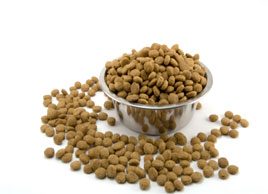How to read pet food labels
Make smarter choices when feeding your pet by knowing what the labels mean

Source: Best Health Magazine, January/February 2010
Are you a label reader? Just as with packaged food for humans, pet food ingredient lists rank contents by weight, from heaviest to lightest. When comparing wet and dry food labels, it may appear dry has less protein than wet, but that’s not necessarily true: Chunks of meat in wet food weigh more than dehydrated proteins in dry food. (That’s why you may see grains, or fillers, higher up on the ingredients list on kibble.)
Check the ‘guaranteed analysis’ (comparable to people food’s ‘nutrition facts’) to see that your pet is getting the protein, carbs and fat your veterinarian recommends. If there isn’t a list, call the toll-free number on the package to ask for it.
Get the go-ahead from your vet before feeding your pet products with health-related claims, such as ‘aids digestion’ and ‘good for sensitive skin,’ recommends Dr. Paul Boutet, past president of the Canadian Veterinary Medical Association.
As for feeding instructions, they are guidelines meant for the average pet. Your vet can advise you based on your own pet’s activity level and any health problems he may have.
Should you feed age-specific food to your pet? Yes. ‘In puppies and kittens, the importance of nutrition in growth and health is well-documented,’ says Boutet, adding that an improper diet can lead to health problems.
Is ‘filler’ good?
Pet food fillers such as rice, corn and oats provide dietary fibre, says Boutet. ‘Fibre is also used in diets designed for weight loss and helps with diabetes,’ he says. But your pet can have too much of a good thing, so talk to your vet to be safe.
This article was originally titled "Deciphering pet-food labels" in the January/February 2010 issue of Best Health. Subscribe today to get the full Best Health experience’and never miss an issue!’and make sure to check out what’s new in the latest issue of Best Health.




